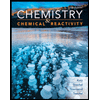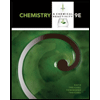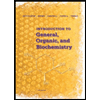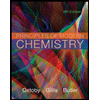
EP CHEMISTRY:CENTRAL..-MOD.MASTERING
14th Edition
ISBN: 9780136781509
Author: Brown
Publisher: PEARSON CO
expand_more
expand_more
format_list_bulleted
Concept explainers
Textbook Question
Chapter 13, Problem 45E
Calculate the molality of each of the following solutions: (a) 8.66 g of benzene (C6H6) dissolved in 23.6 g of carbon tetrachloride (CCl4), (b) 4.80 g of NaCl dissolved in 0.350 L of water.
Expert Solution & Answer
Want to see the full answer?
Check out a sample textbook solution
Students have asked these similar questions
In both the Debye-Huckel equation and the Davies equation, there is a constant A. I see that sometimes it appears as 0.51 and other times as 1.02. Explain why one or the other value is used.
The two equations are forms of the Davies equation, used in thermodynamics for
activity coefficients:
ال
log Y₁ = -Az²
- 0,31
log
= Az²
- 0,31
1 + √Ĩ
1 + √√
k
These equations are consistent and imply that
Yi
=
Is this last equation correct?
k
The two equations are forms of the Davies equation, used in thermodynamics for
activity coefficients:
ال
log Y₁ = -Az²
- 0,31
log
= Az²
- 0,31
1 + √Ĩ
1 + √√
k
These equations are consistent and imply that
Yi
=
Is this last equation correct?
k
Chapter 13 Solutions
EP CHEMISTRY:CENTRAL..-MOD.MASTERING
Ch. 13.3 - Prob. 13.1.1PECh. 13.3 - Prob. 13.1.2PECh. 13.3 - Prob. 13.2.1PECh. 13.3 - Prob. 13.2.2PECh. 13.4 - Prob. 13.3.1PECh. 13.4 - Prob. 13.3.2PECh. 13.4 - Prob. 13.4.1PECh. 13.4 - Prob. 13.4.2PECh. 13.4 - Prob. 13.5.1PECh. 13.4 - Prob. 13.5.2PE
Ch. 13.4 - Prob. 13.6.1PECh. 13.4 - Prob. 13.6.2PECh. 13.5 - Prob. 13.7.1PECh. 13.5 - Prob. 13.7.2PECh. 13.5 - Which aqueous solution will have the lowest...Ch. 13.5 - Prob. 13.8.2PECh. 13.5 - Prob. 13.9.1PECh. 13.5 - Prob. 13.9.2PECh. 13.5 - Prob. 13.10.1PECh. 13.5 - Practice Exercise 2
Camphor (C10 H16 O) melts at...Ch. 13.5 - Prob. 13.11.1PECh. 13.5 - Prob. 13.11.2PECh. 13 - Prob. 1DECh. 13 - Rank the contents of the following containers in...Ch. 13 - This figure shows the interaction of a cation with...Ch. 13 - Consider two ionic solids, both composed of singly...Ch. 13 - Which two statements about gas mixtures are true?...Ch. 13 - Prob. 5ECh. 13 - 13.6 If you compare the solubilities of the noble...Ch. 13 - Prob. 7ECh. 13 - Prob. 8ECh. 13 - Prob. 9ECh. 13 - Prob. 10ECh. 13 - Suppose you had a balloon made of some highly...Ch. 13 - Prob. 12ECh. 13 - Indicate whether each statement is true or false:...Ch. 13 - Indicate whether each statement is true or false:...Ch. 13 - Indicate the type of solute-solvent interaction...Ch. 13 - Indicate the principal type of solute-solvent...Ch. 13 - An ionic compound has a very negative H soln in...Ch. 13 - When ammonium chloride dissolves in water, the...Ch. 13 - Prob. 19ECh. 13 - Prob. 20ECh. 13 - Prob. 21ECh. 13 - KBr is relatively soluble in water, yet its...Ch. 13 - The solubility of Cr (NO3)3 . 9 H2O in water is...Ch. 13 - The solubility of MnSO4 . H2 O in water at 20 C is...Ch. 13 - Prob. 25ECh. 13 - Prob. 26ECh. 13 - Prob. 27ECh. 13 - Prob. 28ECh. 13 - Prob. 29ECh. 13 - Prob. 30ECh. 13 - Would you expect stearic acid, CH3 (CH2)16COOH, to...Ch. 13 - Prob. 32ECh. 13 - Prob. 33ECh. 13 - Prob. 34ECh. 13 - Indicate whether each statement is true or false:...Ch. 13 - 13.36 Indicate whether each statement is true or...Ch. 13 - The Henry’s law constant for helium gas in water...Ch. 13 - Prob. 38ECh. 13 - Prob. 39ECh. 13 - Prob. 40ECh. 13 - Prob. 41ECh. 13 - Prob. 42ECh. 13 - 13.43 Calculate the morality of the following...Ch. 13 - Prob. 44ECh. 13 - Calculate the molality of each of the following...Ch. 13 - (a) What is the molality of a solution formed by...Ch. 13 - Prob. 47ECh. 13 - Prob. 48ECh. 13 - Prob. 49ECh. 13 - The density of toluene (C7H8) is 0.867 g\mL, and...Ch. 13 - Calculate the number of moles of solute present in...Ch. 13 - Calculate the number of moles of solute present in...Ch. 13 - Prob. 53ECh. 13 - Describe how you would prepare each of the...Ch. 13 - Commercial aqueous nitric acid has a density of...Ch. 13 - Prob. 56ECh. 13 - Prob. 57ECh. 13 - Prob. 58ECh. 13 - Prob. 59ECh. 13 - Prob. 60ECh. 13 - Prob. 61ECh. 13 - Prob. 62ECh. 13 - Consider two solutions, one formed by adding 10 g...Ch. 13 - Prob. 64ECh. 13 - Prob. 65ECh. 13 - (a) Calculate the vapor pressure of water above a...Ch. 13 - Prob. 67ECh. 13 - At 20 oC, the vapor pressure of benzene (C6 H6) is...Ch. 13 - Prob. 69ECh. 13 - Prob. 70ECh. 13 - Prob. 71ECh. 13 - Prob. 72ECh. 13 - Using data from Table 13.3, calculate the freezing...Ch. 13 - Prob. 74ECh. 13 - Prob. 75ECh. 13 - Prob. 76ECh. 13 - Prob. 77ECh. 13 - Prob. 78ECh. 13 - Prob. 79ECh. 13 - Lauryl alcohol is obtained from coconut oil and is...Ch. 13 - Prob. 81ECh. 13 - Prob. 82ECh. 13 - The osmotic pressure of a 0.010 M aqueous solution...Ch. 13 - Based on the given data in Table 13.4, which...Ch. 13 - (a) Do colloids made only of gases exist? Why or...Ch. 13 - Prob. 86ECh. 13 - An “emulsifying agent” is a compound that helps...Ch. 13 - Aerosols are important components of the...Ch. 13 - Prob. 89ECh. 13 - Soaps consist of compounds such as sodium state,...Ch. 13 - Prob. 91AECh. 13 - Prob. 92AECh. 13 - Most fish need at least 4 ppm dissolved O2 in...Ch. 13 - The presence of the radioactive gas radon (Rn) in...Ch. 13 - Prob. 95AECh. 13 - Prob. 96AECh. 13 - The maximum allowable concentration of lead in...Ch. 13 - Prob. 98AECh. 13 - Prob. 99AECh. 13 - Prob. 100AECh. 13 - Prob. 101AECh. 13 - The normal boiling point of ethanol, is 78.4 0C....Ch. 13 - Prob. 103AECh. 13 - Carbon disulfide (CS2) boils at 46.30 o C and has...Ch. 13 - Prob. 105AECh. 13 - Prob. 106IECh. 13 - At ordinary body temperature (37 o C), the...Ch. 13 - Prob. 108IECh. 13 - Prob. 109IECh. 13 - Prob. 110IECh. 13 - Prob. 111IECh. 13 - Prob. 112IECh. 13 - At 35 o C the vapor pressure of acetone, (CH3)2CO,...Ch. 13 - Prob. 114IE
Knowledge Booster
Learn more about
Need a deep-dive on the concept behind this application? Look no further. Learn more about this topic, chemistry and related others by exploring similar questions and additional content below.Similar questions
- For the Davies equation, both expressions are correct: log Y₁ = -Az² √i - 0,31 1 + √ k log- = Az - 0,31 k 1 + √Ĩarrow_forwardk In Davies' equation log y₁ = log- log y₁ = log | = -Az² + ✓// k A is a constant that always equals 1.02. Correct? - 0,31arrow_forwardIndicate whether the equality is true Yi How is it obtained? k%arrow_forward
- Indicate the relationship between the activity coefficient YA and the rate constant of a bimolecular reaction in solution k and the rate constant at infinite dilution ko.arrow_forwardDescribe the saline effect that occurs in solutions.arrow_forwardBriefly explain what the infinite dilution rate constant (k∞) consists of.arrow_forward
- The Davies equation corrects the Debye-Hückel limiting law for calculating the activity coefficient of an electrolyte in solution at relatively high concentrations. Mathematically, it is expressed as: log y₁ = -Az²? 1 + √Ĩ - 0,31) Is the formula correct?arrow_forwardDifferentiate between the concepts of "ionic salt effect" and "kinetic salt effect."arrow_forwardDifferentiate the concepts of “salino effect” and “salino kinetic effect”.arrow_forward
- Come and compare the Bronsted-Bjerrum calculation, the Debye and Hückel calculation, and the Davies calculation.arrow_forwardplz watch the youtube video (the title of this topic) by roxi H. she explains it step by step but i get the wrong answerarrow_forwardWriting the rate law implied by a simple mechanism To exit full screen, press and hold esc Suppose the decomposition of ozone proceeds by the following mechanism: step elementary reaction rate constant 1 →>> O3(9) O2(g) + O(g) k₁ 2 03(g) + O(g) → 202(g) k2 Suppose also k₁ »k2. That is, the first step is much faster than the second. Write the balanced chemical equation for the overall chemical reaction: Write the experimentally- observable rate law for the overall chemical reaction. ☐ rate = ☐ Note: your answer should not contain the concentrations of any intermediates. Express the rate constant k for the overall chemical reaction in terms of K1, K2, and (if necessary) the rate constants k-1 and K-2 for the reverse of the two elementary reactions in the mechanism. k = ☐ 000 18 ローロ Ar OOarrow_forward
arrow_back_ios
SEE MORE QUESTIONS
arrow_forward_ios
Recommended textbooks for you
 Chemistry & Chemical ReactivityChemistryISBN:9781337399074Author:John C. Kotz, Paul M. Treichel, John Townsend, David TreichelPublisher:Cengage Learning
Chemistry & Chemical ReactivityChemistryISBN:9781337399074Author:John C. Kotz, Paul M. Treichel, John Townsend, David TreichelPublisher:Cengage Learning Chemistry & Chemical ReactivityChemistryISBN:9781133949640Author:John C. Kotz, Paul M. Treichel, John Townsend, David TreichelPublisher:Cengage Learning
Chemistry & Chemical ReactivityChemistryISBN:9781133949640Author:John C. Kotz, Paul M. Treichel, John Townsend, David TreichelPublisher:Cengage Learning Chemistry: Principles and ReactionsChemistryISBN:9781305079373Author:William L. Masterton, Cecile N. HurleyPublisher:Cengage Learning
Chemistry: Principles and ReactionsChemistryISBN:9781305079373Author:William L. Masterton, Cecile N. HurleyPublisher:Cengage Learning Introduction to General, Organic and BiochemistryChemistryISBN:9781285869759Author:Frederick A. Bettelheim, William H. Brown, Mary K. Campbell, Shawn O. Farrell, Omar TorresPublisher:Cengage Learning
Introduction to General, Organic and BiochemistryChemistryISBN:9781285869759Author:Frederick A. Bettelheim, William H. Brown, Mary K. Campbell, Shawn O. Farrell, Omar TorresPublisher:Cengage Learning Principles of Modern ChemistryChemistryISBN:9781305079113Author:David W. Oxtoby, H. Pat Gillis, Laurie J. ButlerPublisher:Cengage Learning
Principles of Modern ChemistryChemistryISBN:9781305079113Author:David W. Oxtoby, H. Pat Gillis, Laurie J. ButlerPublisher:Cengage Learning Chemistry: The Molecular ScienceChemistryISBN:9781285199047Author:John W. Moore, Conrad L. StanitskiPublisher:Cengage Learning
Chemistry: The Molecular ScienceChemistryISBN:9781285199047Author:John W. Moore, Conrad L. StanitskiPublisher:Cengage Learning

Chemistry & Chemical Reactivity
Chemistry
ISBN:9781337399074
Author:John C. Kotz, Paul M. Treichel, John Townsend, David Treichel
Publisher:Cengage Learning

Chemistry & Chemical Reactivity
Chemistry
ISBN:9781133949640
Author:John C. Kotz, Paul M. Treichel, John Townsend, David Treichel
Publisher:Cengage Learning

Chemistry: Principles and Reactions
Chemistry
ISBN:9781305079373
Author:William L. Masterton, Cecile N. Hurley
Publisher:Cengage Learning

Introduction to General, Organic and Biochemistry
Chemistry
ISBN:9781285869759
Author:Frederick A. Bettelheim, William H. Brown, Mary K. Campbell, Shawn O. Farrell, Omar Torres
Publisher:Cengage Learning

Principles of Modern Chemistry
Chemistry
ISBN:9781305079113
Author:David W. Oxtoby, H. Pat Gillis, Laurie J. Butler
Publisher:Cengage Learning

Chemistry: The Molecular Science
Chemistry
ISBN:9781285199047
Author:John W. Moore, Conrad L. Stanitski
Publisher:Cengage Learning
Solutions: Crash Course Chemistry #27; Author: Crash Course;https://www.youtube.com/watch?v=9h2f1Bjr0p4;License: Standard YouTube License, CC-BY